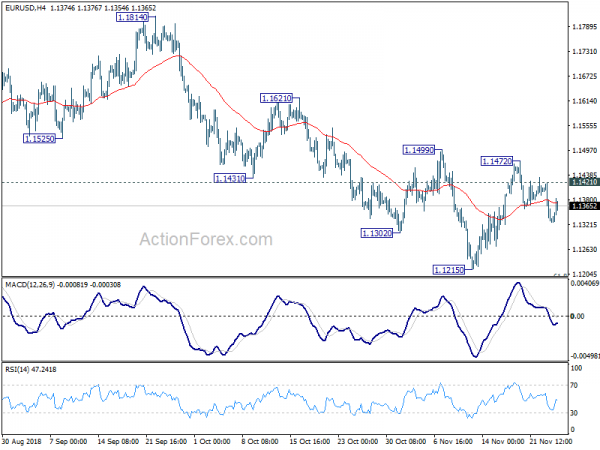Euro, Sterling, Australian and New Zealand Dollar are so far the stronger ones today. Euro is lifted by news that Italy is finally showing some flexibility to adjust it’s 2019 budget deficit target. The development also send European stocks higher and Italian yield lower. Improvement in risk appetite helps lift Aussie and Kiwi slightly. Meanwhile, in such market sentiments, Yen, Dollar and Swiss Franc are naturally the softest ones.
Technically, though, the movements in the forex markets are rally limited. EUR/USD is held well below 1.1421 minor resistance despite today’s recovery. And EUR/JPY stays below 129.10 minor resistance too. GBP/USD is kept well below 1.2927 minor resistance. And GBP/JPY is held below 145.90 minor resistance. AUD/USD is staying close to mid-point of range of 0.7164/7325. That is, the impact developments in Italy and Brexit may not last too long.
In other markets, at the time of writing, FTSE is up 0.67%, DAX is up 1.13%, CAC is up 0.58%. German 10 year yield is up 0.0184 at 0.362. Italian 10 year yield is down notably by -0.132 at 3.282. German-Italian spread is now back below the 300 alarming level. Earlier in Asian, Nikkei closed up 0.76%, Hong Kong HSI gained 1.73%, Singapore Strait Times rose 1.34%. But China Shanghai SSE dropped -0.14%. This is a risk to the global markets.
Italy toned down on budget deficit target, open to adjustment
Euro is given a lift on reports that the Italian coalition is considering adjustment on its 2019 budget plan. It started with Il Messaggero newspaper quoting Armando Siri, a Transport Ministry undersecretary saying that “In order to save the budget and avoid an increase in market turbulence … a small fine-tuning (of the deficit target) could be considered.”
Then, it’s reported that Deputy Prime Minister, leader of Five-Star Movement, Luigi Di Maio also said deficit target reduction is not a problem as long as budget measures remain the same. He said in a radio interview that “what is important is that the budget contains the goals that we have established.” He referred to the measures including citizen’s income, and increase in retirement age. And, he added “then if the negotiation means that the deficit (target) must come down a bit, for us it’s not important.” Di Maio emphasized that “citizens are more important than numbers.”
The cabinet is expected to meet today in the evening to discuss reduction of the 2.4% deficit target of 2019. And that could open up the door for constructive dialogue with the European Commission to avoid Excessive Deficit Procedure.
German Ifo dropped to 102, points to 0.3% Q4 GDP growth at most
German Ifo business climate dropped to 102.0 in November, down from 102.9 and missed expectation of 102.3. Current assessment gauge dropped to 105.4, down from 106.1 and missed expectation of 105.6. Expectations gauge dropped to 98.7, down from 99.7, missed consensus of 99.3.
Ifo President Clemens Fuest noted in the release that “Together with other indicators, these results point to 0.3 percent economic growth in the fourth quarter at most. The German economy is cooling down.”
EU publishes joint proposals with other members on WTO reforms
EU published the proposal of reform of the WTO’s Appellate Body today, for presentation on the General Council meeting on December 12. The proposal is a joint effort with other WTO members including Australia, Canada, China, Iceland, India, Korea, Mexico, New Zealand, Norway, Singapore and Switzerland.
EU Trade Commissioner Cecilia Malmström said in the press release that “the appellate body function of the WTO dispute settlement system is moving towards a cliff’s edge. Without this core function of the WTO, the world would lose a system that has ensured stability in global trade for decades. Now, together with a broad coalition of WTO members, we are presenting our most concrete proposals yet for WTO reform. I hope that this will contribute to breaking the current deadlock, and that all WTO members will take responsibility equally, engaging in good faith in the reform process.”
UK PM May to address the Parliament on Brexit, call for support
UK Prime Minister Theresa May is expected to make a statement at around 1530 GMT in the parliament on completing the negotiation with the EU on withdrawal agreement and future relationship. May would also call the Commons to back the deal that allows UK to “move on”. Or, “this House can choose to reject this deal and go back to square one … It would open the door to more division and more uncertainty, with all the risks that will entail.”
The last step on the UK side is for the parliament to ratify the agreement. This remaining 1% is probably the most challenging task for the whole Brexit deal. The key date to remember now is January 21, 2019. There is a UK legal requirement that the government has to reach an agreement with the EU by then. If the parliament rejects the deal, the Government has until that day to put forward a new plan. The government is likely to use the brinkmanship strategy, threatening to leave the EU with no-deal on March 29, 2019, if the parliament rejects the current agreement.
More in Brexit Update – The Remaining 1%, The Most Challenging
Japan PMI manufacturing dropped to 51.8, underlying trend skewed to the downside
Japan PMI manufacturing dropped to 51.8 in November, down from 52.9 and missed expectation of 53.0. That’s also a two-year low. Joe Hayes, Economist at IHS Markit, noted in the release that “October’s six-month peak seems to have been just a transitory month-to-month rebound”. And, “the underlying trend appears to be skewed to the downside.”. “Indeed, the fall in new orders is a worrying development as easing global growth momentum coupled with a weak domestic backdrop could spell further demand woes for Q4.”
BoJ Kuroda: It’s possible to shrink the balance while keeping markets stable
BoJ Governor Haruhiko Kuroda appeared in the Parliament again today. He clarified that the objective of the quantitative and qualitative easing problem was to lift inflation to 2% target, rather than bankrolling the government debt.
He also pointed out “how to deal with the BOJ’s expanded balance sheet would be among key challenges for us when we were to exit from quantitative easing.” However, “past experience of other central banks indicate that with a good mix (of redemption and re-investment of bonds), it’s possible to shrink our balance sheet at an appropriate pace, while keeping markets stable.”
EUR/USD Mid-Day Outlook
Daily Pivots: (S1) 1.1303; (P) 1.1362; (R1) 1.1397; More…..
EUR/USD recovers mildly today but with 1.1421 minor resistance intact, deeper fall is still expected for 1.1215 support. Break there will resume larger down trend for 1.1186 fibonacci level next. On the upside, above 1.1421 minor resistance will turn intraday bias back to the upside for 1.1499 resistance. Firm break there will indicate near term reversal and turn outlook bullish for 1.1814 key resistance.
In the bigger picture, down trend from 1.2555 medium term top has just resumed and should target 61.8% retracement of 1.0339 (2017 low) to 1.2555 at 1.1186 next. Sustained break there will pave the way to retest 1.0339. On the upside, break of 1.1814 resistance is now needed to confirm medium term bottoming. Otherwise, outlook will stay bearish in case of strong rebound.
Economic Indicators Update
| GMT | Ccy | Events | Actual | Forecast | Previous | Revised |
|---|---|---|---|---|---|---|
| 21:45 | NZD | Retail Sales Ex Inflation Q/Q Q3 | 0.00% | 1.00% | 1.10% | |
| 0:30 | JPY | PMI Manufacturing Nov P | 51.8 | 53 | 52.9 | |
| 9:00 | EUR | German IFO Business Climate Nov | 102 | 102.3 | 102.8 | 102.9 |
| 9:00 | EUR | German IFO Expectations Nov | 98.7 | 99.3 | 99.8 | 99.7 |
| 9:00 | EUR | German IFO Current Assessment Nov | 105.4 | 105.6 | 105.9 | 106.1 |
| 9:30 | GBP | BBA Mortgage Approvals Oct | 39.7K | 38.9K | 38.5K | 38.7K |















